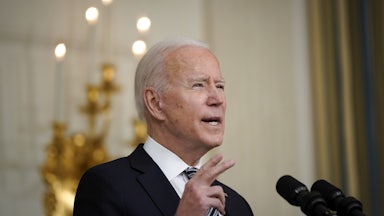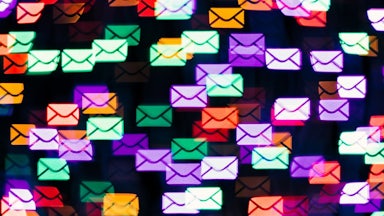So far green groups have largely praised the Biden administration—its quick cancellation of the Keystone XL pipeline, its recommitment to the Paris Agreement, and other early steps. But now, as Biden prepares to provide details on his Build Back Better Agenda in Pittsburgh on Wednesday, progressive and environmental organizations say they’re looking for more.
The White House has recently indicated that it hopes to spend $400 billion on climate priorities as part of the Build Back Better Agenda. Last week, progressive political action committee Justice Democrats and the climate-focused Sunrise Movement called for that number to be increased, the latter suggesting $10 trillion of investment over the next decade. On Friday, Axios reported that the Congressional Progressive Caucus is coalescing around a bigger climate ask, too, as the narrow window for what will likely be reconciliation packages closes.
The last time there was an opening for major federal climate policy was over a decade ago, during the cap-and-trade battle, when the environmental groups supporting the bill were mostly organized into a single lobbying arm. The Environmental Defense Fund—the venerable conservationist outfit—was steering the ship of the U.S. Climate Action Partnership, an alliance formed in 2007 between big Beltway green groups and the country’s biggest polluters.
This time around things are more diffuse, with loosely overlapping activist groups pushing for various things to be included in the infrastructure package the Biden administration has said it will be championing, or some other big omnibus package. And progressive groups—including many formed during the Trump administration—are striking a tricky balance: forging relationships with the new administration and Democratic lawmakers, while pushing them to go bigger.
Plenty of things are different in the climate fight a decade later: Democrats control the Senate with just 50 votes, not 59. And the residue of the Koch-funded right-wing vitriol from that fight still lingers. Most of the Republican Party remains staunchly opposed to anything that smells like climate policy. Mitt Romney and Lindsey Graham occasionally express some theoretical openness to carbon pricing, but the zeitgeist among D.C. climate wonks and administration officials has shifted toward talk of standards, investment, and justice. That’s due in no small part to internal organizing within a climate movement that’s increasingly picking up demands from longtime climate and environmental justice organizers, as well as the Green New Deal’s explosion onto the scene in 2018. Upstart think tanks like Evergreen Action—whose co-founder Maggie Thomas was tapped for a top job at the White House Office of Domestic Climate Policy—have been hard at work pitching a Clean Electricity Standard, aimed at zeroing out power sector emissions by 2035.* A toned-down and more fossil fuel–friendly version of that policy appears in the 981-page CLEAN Future Act, introduced by Paul Tonko and Frank Pallone of the Energy and Commerce Committee, with backing from the BlueGreen Alliance between big greens and a number of labor unions eager to see a gradual move away from coal, oil, and gas.
Formed in the hopes of pushing forward a broader climate agenda, the Green New Deal Network, or GNDN, looks loosely similar to a number of other coalitions formed in the wake of Trump’s election, bringing together the national leadership from prominent progressive groups with the goal of aligning on a core set of priorities and coordinating foundation funding to help meet them. Its members are 15 groups, many with affiliate member groups spread out around the country: the Center for Popular Democracy, Climate Justice Alliance, Grassroots Global Justice Alliance, Greenpeace, Indigenous Environmental Network, Indivisible, Movement for Black Lives, MoveOn, People’s Action, Right to the City Alliance, Service Employees International Union, Sierra Club, Sunrise Movement, U.S. Climate Action Network, and the Working Families Party.
The GNDN has coalesced around what’s called the THRIVE Agenda, which stands for Transform, Heal, and Renew by Investing in a Vibrant Economy. The THRIVE resolution—a nonbinding statement of principles introduced by now–interior secretary and former New Mexico Congresswoman Deb Haaland last year—gained support from over 100 Democratic lawmakers in the House and Senate. The THRIVE Act being unveiled Monday and formally introduced in mid-April outlines $1 trillion of annual investment over a decade, with the goal of creating 15 million jobs. It also establishes a mechanism for how to distribute the funds so as to ensure that at least 50 percent of climate investments flow to marginalized communities, including communities of color and those most vulnerable to the climate crisis.
A 13-page draft of the bill, dated February 24 and provided to The New Republic by those familiar with the matter, builds on the strong labor, environmental justice, and Indigenous sovereignty protections inscribed in last year’s resolution, and aims to achieve 100 percent clean energy by 2035 and 100 percent zero-emission new buildings by 2025, with provisions for home care workers and agriculture. Though the draft does not outline a direct way to phase out fossil fuels, it specifies that funds allocated by the THRIVE Act cannot be used to “expand extraction, processing, or use of fossil fuels or uranium at any level of the supply chain; the use of emissions offsets; geoengineering.”
While the Green New Deal is in the name of the network, the phrase itself is absent from the agenda, the resolution, and the draft text. The THRIVE resolution’s 102 co-sponsors in the House and Senate overlap considerably with the 117 who co-sponsored the Green New Deal resolutions in the House and Senate in 2019. The THRIVE Act is being helmed in the House by Michigan Representative Debbie Dingell, who did not co-sponsor the House Green New Deal resolution, and in the Senate by Ed Markey, who co-introduced it in the Senate in 2019.
Those I spoke with who are involved in THRIVE describe it as a “down payment” on the Green New Deal, formed largely in response to the pandemic with an eye toward recovery packages in a prospective Democratic administration. “An economic renewal package isn’t going to do everything, and we don’t see it as everything that needs to be done,” Ben Beachy, who directs the Sierra Club’s Living Economy program, said of THRIVE. Avoiding Green New Deal language and some of the more ambitious demands of a Green New Deal for now, he told me, is seen as a means to broaden the tent, attracting organizations and lawmakers who are wary of explicitly Green New Deal language. Many of the people I spoke with pointed to Chuck Schumer’s support for the THRIVE resolution last year, along with endorsements from a number of labor unions beyond SEIU, as evidence the strategy was working. Still, while crafted to appeal to a broader tent, the THRIVE resolution didn’t garner more co-sponsors than the Green New Deal resolutions did in 2019. And THRIVE has yet to muster the same level of public interest and media attention.
“I’ve worked in a lot of coalitions, and I’ve never seen something as real and earnest as the GNDN,” said Kaniela Ing, climate justice campaigns director for People’s Action. “We have labor, Indigenous groups, groups that focus on fossil fuels mostly, and those that focus mostly on investment. We have groups that were on different sides of the election in the primary.… It’s not always easy to maintain, and it takes constant work to struggle through it.”
Much of the GNDN’s considerable funding is devoted to its “50-state strategy,” which aims over the long term to build out state and local coalitions similar to the one at the national level as part of an effort that can extend beyond upcoming reconciliation fights, and to support climate legislation down the line. It’s modeled in broad strokes on Health Care for America Now, or HCAN, which mobilized both in congressional districts and in D.C. behind passing the Affordable Care Act in Obama’s first term. It’s also an attempt to correct for the U.S. Climate Action Partnership’s insider-only strategy of building support among big greens, lawmakers, and business. HCAN, by contrast, in uniting behind a call for a public option, “allowed people to push for the health care bill without feeling like they were selling out,” said political sociologist Theda Skocpol.
Climate advocates looking to pass cap and trade in the Obama era structured their policy agenda in large part to suit polluters, hoping their backing would be a gateway to Republican support. In the process, they spurned more progressive groups that could have ramped up pressure on lawmakers to stay the course, preferring big ad buys to the more decentralized district-by-district advocacy for federal policy undertaken by HCAN. When pressure from the right ramped up and already thin GOP support dropped off, there weren’t many people beyond Capitol Hill willing to keep up the fight.
The GNDN is now in the process of expanding its modest staff, including with a skeleton crew of less than half a dozen field organizers tasked with supporting state-level work. For now, they’re focused on an initial list of 20 states, where there’s a mix of existing coalitions and new formations. The network hopes to be backing operations in 33 states by the end of the year. Its first coordinated action will be through what’s called a “Recovery Recess,” when state coalitions will participate in a week of demonstrations in key congressional districts around the spring recess kicking off this week, aimed at recruiting co-sponsors to the THRIVE Act beyond its initial 10 lead co-sponsors in the House and Senate. The extent to which the funds being dispersed by GNDN will be spent on pushing for its federal policy priorities beyond that week is up to some interpretation. “We recognize the value of resourcing strong community organizers across the U.S. The majority of funds go to existing groups in the states,” Ing told me. “There’s a lot of autonomy for groups to organize as they see fit in their communities, with the understanding that we need federal action. We need massive nonviolent direct action everywhere. We need state and local legislation. We need to engage in elections. We want to help support all of that.”
While the THRIVE Act is a sort of historical high-water mark for progressive groups getting on the same page, there’s also a hunger on and around Capitol Hill for further and more pointed coordination. A letter signed by several dozen organizations set to be released before Biden’s speech on Wednesday calls for $16 trillion of green infrastructure investments over four years, with at least half of that designated for marginalized communities disproportionately affected by both fossil fuels and climate change. Offices of the congresspeople known as the “Squad” have mostly not been heavily engaged in the THRIVE process, and Representative Alexandria Ocasio-Cortez’s office confirmed that it’s not involved at this point, after having signed on to the resolution last year. Ocasio-Cortez’s office plans to reintroduce the Green New Deal resolution with new co-sponsors and supporting organizations. Along with Representative Andy Levin and Senator Elizabeth Warren, Ocasio-Cortez also recently announced a $500 billion plan to electrify public transit. Her office has championed a $172 billion Green New Deal for public housing, alongside Bernie Sanders in the Senate, as well.
Representative Jamaal Bowman—a former principal and co-sponsor of the THRIVE Act—has in recent weeks released legislation for a $1.2 trillion plan to retrofit public schools to run on renewable energy and hire more teachers and support staff. “We’ll start with the highest-need schools, those that have suffered from decades of disinvestment. We will be turning this vision into legislation, and very much want it to be part of the conversation on the next stimulus package,” Bowman said over email. Having released a Care for All Agenda as a resolution earlier this month, he’s also hoping to expand the conversation on climate-smart infrastructure to include more than renewable energy buildouts and traditional hard-hat jobs.
Behind the scenes, staffers in left-of-center offices have been working to organize support behind a package of new and existing bills that could pose a counterweight to the CLEAN Future Act and other establishment proposals by calling for actual limits on fossil fuels, as well as setting more ambitious 2030 emissions targets. A call last Wednesday featured 20 congressional staffers—including from the offices of Representatives Ocasio-Cortez and Cori Bush and Senator Jeff Merkley—as well as around 30 organizations, Oil Change International Senior Campaigner Collin Rees, who joined the call, told me. “It’s exciting to see progressives in Congress recognizing the need to confront fossil fuel expansion, which will be critical to meet the Biden administration’s goals on environmental and climate justice,” he said.
Sunrise, which joined the call, is partaking in the Recovery Recess Actions as part of the GNDN and will be continuing to collect signatures on its Good Jobs for All Pledge, which is intended to build support for larger-scale recovery legislation. The pledge is intended to complement “other pieces of legislation and resolutions,” Sunrise legislative coordinator Lauren Maunus said, referencing several of the measures above. “There are different roles for Sunrise, the Squad, and the [GNDN] coalition to play. And we need everyone to be holding their role well to move forward.”
The Congressional Progressive Caucus is in the process of deciding on its priorities for an infrastructure bill. Members hold differing opinions about how much to invest over how long and are deciding from a menu of policy options, including ensuring that 50 percent of climate investments are directed toward frontline communities, per the THRIVE Agenda, as well as direct job creation. Sources say they’re also looking toward potential areas of agreement with the administration where they may be able to push for more, including a National Investment Authority and Clean Electricity Standard. On the latter, one senior aide to a progressive member told me, “obviously we want something that is bolder than what the Energy and Commerce Committee has proposed,” referring to the CLEAN Future Act.
The biggest open question is how any of the above will survive reconciliation, and how the White House plans to introduce the Build Back Better Agenda. According to recent reporting, that could involve parceling out the proposed $3 trillion investments into one bill focusing on traditional areas like roads and bridges and another bill with climate priorities, as well as broader safety net expansions and immigration reform. “If they say ‘bipartisan,’ the first thing on the chopping block would be climate. That is our concern and why we think the best thing is to go as bold as possible on one big bill. Unless we get to a point where we get rid of the filibuster,” the aide added. “There’s very little good climate policy that can get done with 60 votes in the Senate.”
* This sentence has been corrected to reflect Maggie Thomas’s current position.








